Rocky Marciano-Archie Moore remembered
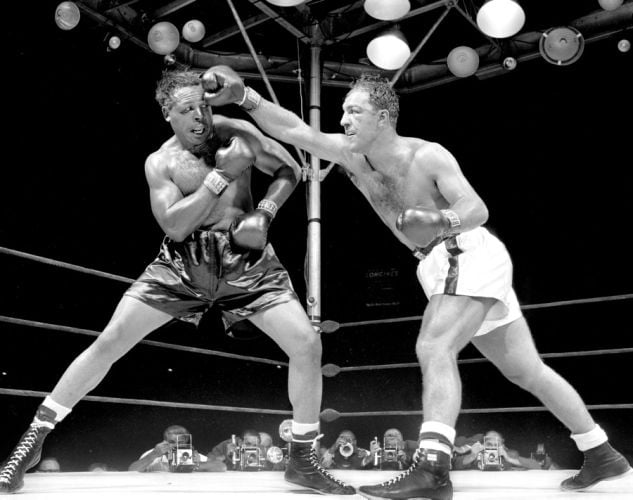

Rocky Marciano watches trainer Charley Goldman lace up his gloves as manager Al Weill looks on during a workout at Grossinger’s Gym in New York prior to his heavyweight title defense against Archie Moore. Photo by THE RING magazine / Getty Images
Sixty years ago, yesterday, on Sept. 21, 1955, Rocky Marciano authored the final chapter of a legacy that has only grown with time. No one – not even Marciano – knew at the time that his ninth-round knockout of reigning light heavyweight champion Archie Moore would be the last time he would pull on the gloves as an active participant. And no one could have ever guessed that his final record – 49-0-0, with 43 knockouts – would become so iconic.
On April 27, 1956 – more than seven months after beating Moore – Marciano called a hastily arranged news conference at the Hotel Shelton in New York City and told the world he was ending his professional boxing career. With that act, Marciano joined a select group of athletes who retired on top – and stayed retired. In the six decades since his departure, several legendary fighters had zoomed past his mythical mark but, because they continued their pursuits of excellence, their records inevitably were stained by losses or draws. Julio Cesar Chavez ran his record to 87-0-0 before Pernell Whitaker affixed a draw that should have been a win for the slick American southpaw. Nino Benvenuti ran off 65 consecutive wins until Ki Soo Him ended his run and captured the Italian’s world junior middleweight title before the Korean’s home fans in Seoul. Willie Pep began his career with 62 straight victories and it took the likes of Sammy Angott, who, just three fights after beating Pep, would regain the lightweight title he voluntarily relinquished.
Others came closer to the finish line: Ricardo Lopez ended his career at 51-0-1 but, in fight 48 against Rosendo Alvarez, a freakish technical draw ended his run at perfection. Larry Holmes famously ran his record to 48-0 and seemed likely to equal Marciano when he signed to fight reigning light heavyweight king Michael Spinks. Fifteen rounds later, history indeed was made; Spinks won a split decision to become the first 175-pound monarch to win the heavyweight title while a bitterly disappointed Holmes was left to rail at Marciano’s ghost.
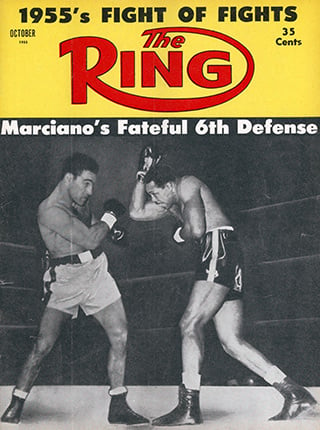
Photo: THE RING
Because so many great champions – and eventual Hall of Famers – failed to match Marciano’s final mark, the magic surrounding it has only increased with each passing year. The promotional centerpiece of Floyd Mayweather Jr.’s recent fight with Andre Berto was his attempt to tie “The Brockton Blockbuster’s” numerical achievement. While the man named “Money” accomplished his task with expected ease, the cautious and highly technical manner in which he earned his 49th consecutive victory without a loss was the complete antithesis of the way Marciano’s fight with Moore played out. While Mayweather orchestrated a well-executed and well-compensated boxing exhibition against an opponent of his choosing, Marciano’s manager reluctantly approved Moore only after the aspiring challenger exerted massive public pressure. The fight itself was among the year’s best; both men hit the canvas and, throughout the contest, they displayed the assets that made them ring immortals. In the end, Marciano’s supreme conditioning, unparalleled drive and pulverizing power got the best of the crafty “Old Mongoose.”
Marciano’s mark continues to be revered because his is the longest undefeated and untied final record among fighters who became world champions. Despite being just 32 years old at the time of his departure, the Rock never again tempted fate by launching a comeback that could have irreparably soiled the sheen his perfect record provided.
Marciano couldn’t have asked for a better way to exit the sporting stage than by beating a fellow legend in Moore. But as good as the in-ring combat was, the story lines surrounding their fight were even better.
*
Biographer Russell Sullivan wrote in his book, “Rocky Marciano: The Rock of His Times,” that the image-makers of the era depicted Marciano as a man of his time because, outside the ring, he personified qualities that resonated with the public at large. The words and terms most often used to describe Marciano were “solid,” “decent,” “modest,” “patriotic,” “blue-collar,” “friendly,” “God-fearing,” “loyal” and “respectful.” Moreover, the core that shaped Marciano the man carried over to the way he plied his trade, both in training and during fights. He isolated himself from his wife and children for months at a time to whip his muscular frame into impeccable condition, after which he’d steamroll opponents into submission with an unending succession of sledgehammer blows. Even though he always walked out of the ring as the winner, he still was perceived as the ultimate overachiever, a man who made the most of every gift he was bestowed.
The reasons for this reputation were self-evident. At 5-feet-10 1/2 inches, he, along with fellow Massachusetts native John L. Sullivan, was the second shortest ever to hold the world heavyweight championship behind the 5-foot-7 Tommy Burns Marciano’s 68-inch reach remains, by far, the shortest ever owned by a heavyweight titleholder. His lack of size combined with his profound lack of ring pedigree – the aspiring Major League catcher didn’t begin boxing until his early-20s – resulted in a ring style that was crude, brutish and difficult for ring connoisseurs to watch. Even after years of instruction from legendary trainer Charley Goldman, Marciano remained a hittable target with chronically breakable brows that, over time, spilled quarts of crimson on the canvas.
And yet he won. Every…single….time.
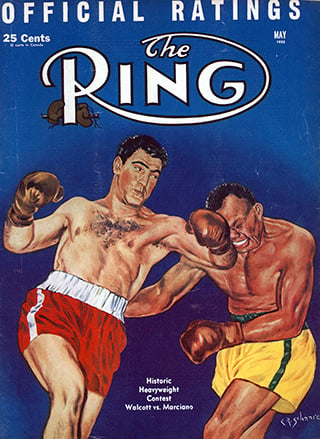
Photo: THE RING
His triumphs over adversity struck a chord with the public and his popularity remained strong even after he knocked out (and retired) the beloved Joe Louis in Oct. 1951. His title-winning fight over Jersey Joe Walcott 11 months later was a microcosm of the Marciano legend as he overcame a first-round knockdown (the first of his professional career) and mid-fight blindness (thanks to either the liniment on Walcott’s body or the cut medicine used on Marciano) to land arguably the single hardest punch in ring history early in round 13. As Walcott inched back toward the ropes, Marciano inched forward to maintain his ideal distance. Both chose the exact moment to unleash right hands but because Rocky’s was triggered a split-second earlier and assumed a far more direct path, his blow struck the target first – and did so with titanic force. The blow instantly anesthetized Walcott’s body and referee Charley Daggert could have tolled 10 counts of 10 if he needed to do so. The one he levied over Walcott was more than sufficient.
Even though Marciano continued to triumph, he still didn’t win everyone over. His 145-second knockout win over Walcott in the rematch was wholly unsatisfying in comparison to the classic original and though Marciano stopped Roland LaStarza, he was out-boxed over long stretches. He twice conquered former champ Ezzard Charles, who, after the fact, was judged to be far past his prime and Briton Don Cockell’s pudgy appearance, combined with Marciano’s slow start and general awkwardness, took away from the champ’s ninth-round TKO victory.
Though a popular champion who had been involved in the last three Fights of the Year as deemed by THE RING magazine, Marciano still hadn’t gained universal respect as a great fighter. The only way to achieve that status was to thoroughly defeat another truly great fighter.
That’s where Archie Moore came in.
Moore was Marciano’s opposite in every conceivable way. While Marciano was a straightforward, uncomplicated character, Moore loved to shroud himself in mystery. Sullivan noted that even the most mundane details of his life were points of dispute. His name was either Archibald Lee Moore, Archibald Louis Moore or, as it turned out, Archibald Lee Wright (he changed his name to “Moore” in honor of the aunt and uncle who raised him). Moore said he was born in Collinsville, Ill. on Dec. 13, 1916, while his mother reported he came into the world in Benoit, Miss. on Dec. 13, 1913, while, at other times, Moore claimed himself to be a son of St. Louis. A check of the 1920 Census surprisingly revealed that he, not his mother, was correct on the matter of his age and place of origin.
While Marciano was rugged and unpolished inside the ring, Moore fancied himself as an artistic craftsman who analyzed his opponents, plotted meticulous ring strategies and executed his blueprints with crisp, concise blows. His cerebral ring style was an extension of his overall persona, which was professorial, philosophical and occasionally profound. Reporters were impressed by his expansive vocabulary, his precise diction and his spoken-word essays on “escapology” and “relaxism.”
The raw numbers spoke loudly of his punching power but no one envisioned Moore as a wrecking-ball wild man bent on destruction like other knockout artists. Instead, Moore spent considerable time scanning his opponents behind a rolling cross-armed posture he called the “armadillo defense” and struck only when he felt the conditions were right. Very seldom did he deliver a looping, off-balanced blow and “Shadowbox” author George Plimpton, who sparred three rounds with Moore at Stillman’s Gym, noted that Moore’s vocal chords emitted a low, hypnotic hum that suddenly rose just before he’d launch a bomb.
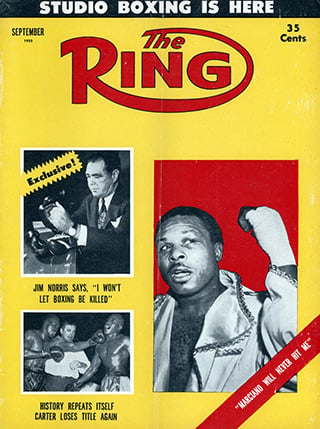
Photo: THE RING
Unlike Marciano, who never fought outside the U.S. and only twice ventured beyond the northeastern part of the country (Walcott II in Chicago, Cockell in San Francisco), Moore was a bona fide ring gypsy. To this point in his ring life, Moore had fought in 37 U.S. cities in 24 states as well as in Argentina, Australia, Panama and Uruguay. Because he had no stable management for years, he simply fought anywhere that would have him and anyone willing to step in the ring with him. That ultimately resulted in losses, several of which happened inside the distance. According to Boxrec.com, Moore entered the Marciano bout with a record of 148-19-8 with one no-contest, including 107 wins (and four losses) coming by KO.
Those blemishes occurred just often enough to lock him out of the championship picture for more than a decade. A fateful meeting in March 1949 with Bob Reece, the owner of a Toledo car dealership, marked a significant turning point in Moore’s life. After hearing Moore’s story, Reece offered to become his financial backer and, from that point, Moore, who, for the first time, had a genuine team behind him, became a consistent winner. From March 23, 1949 until the Marciano fight Moore was 48-2-1 (33) and win number 33 proved to be the most important. On Dec. 17, 1952, four days after turning 36 and performing before his adopted home fans in St. Louis, Moore finally became a world champion after comprehensively out-pointing light heavyweight king Joey Maxim.
For the next couple of years, Moore yo-yo-ed between 175 and heavyweight in the hopes of securing a shot at Marciano’s crown but he soon learned his excellence inside the ring wouldn’t be enough to lure the Blockbuster into the ring with him. It was at this juncture where he decided to dig into the playbook that proved so successful in getting Maxim to grant him his first title shot.
“I began a letter-writing campaign to sports writers all over the country,” Moore wrote in his autobiography about his previous effort. “I pleaded; I cursed; I demanded a shot at Maxim’s crown. The boys on the sports desk were great but not a one of them was a matchmaker. Meanwhile my manager kept reminding me how old Joe Walcott was when he got a title shot. I believe Charley Johnson thinks I have the mind of a four-year-old.” But just as Moore was about to let his contract with the laissez-faire Johnson expire, Johnson called Moore to inform him that the match with Maxim had been finalized.
With the help of Reece and several other Toledo backers, Moore launched an even more ambitious campaign to snag a fight with Marciano. According to Sullivan’s biography of Marciano, Moore and his team initially mailed 427 letters and telegrams to sports editors pumping up a potential Marciano-Moore fight, then expanded their mailing list to more than 500. They commissioned a poll of sportswriters and the results revealed that 992 of the 1,134 respondents wanted to see the match (though 787 picked Marciano to win). They enlisted Toledo Blade cartoonist Walt Buchanan, who, free of charge, drew caricatures of Marciano. Moore even reached out directly to the champion; one year-end greeting suggested that Marciano resolve to grant Moore a fight in 1955.
Perhaps the crowning gambit of Moore’s crusade was a poster that read as follows: “Wanted: Reward for Capture and Delivery of Rocky Marciano to Any Ring in the World for the Purpose of Defending His Heavyweight Championship Against the LOGICAL contender ARCHIE MOORE. Reward: the Boxing Public Will See a Great Fight and Witness the Crowning of a New Champion. Advise (Sheriff) Archie Moore.”
Although the general target was the sporting public, the person they wanted to persuade most was Marciano’s manager, Al Weill. Moore knew that only enormous public pressure would force Weill into green-lighting the match. But pressure alone wouldn’t be enough to move Weill; pressure plus performance would.
After scoring an off-the-floor 14th round knockout over Harold Johnson to retain his light heavyweight crown, Moore traveled to Las Vegas and out-pointed number-one heavyweight contender Nino Valdes over 15 rounds to cement his credentials at the higher weight. Then, just 51 days later, Moore, who weighed 196 1/2 against Valdes, somehow sweated down to 175 and met middleweight champion Carl “Bobo” Olson, with the winner guaranteed a crack at Marciano. Moore polished Olson off in three rounds and just like that, Marciano-Moore became a reality.
The fight received extraordinary media attention and Moore used the lead-up not only to condition his body but also to cement his persona to the masses. When asked how he was able to defeat Olson so convincingly after shedding 21 1/2 pounds so quickly, Moore cited a “secret” diet given to him by Australian aborigines, which included drinking sauerkraut juice mixed with a teaspoon of lemon as well as chewing meat but not swallowing the bulk. Moore clearly enjoyed holding court with the crowds that watched him train, for it gave him the chance to expound on subjects far and wide.
“He’s an actor by preference, a spellbinding spieler,” wrote columnist Red Smith. “He even makes up like a Shakespearean ham, with his Mephistophelean mustache and chin whiskers. All his life he’s been playing summer stock in converted barns. Now, for the first time, he’s hit Broadway. He has an audience worthy of his immeasurable art. It must be a great comfort to him.”
Marciano trained at Grossinger’s in the Catskills but he didn’t prepare with his legendary intensity as he logged just 116 rounds of sparring, the lowest amount of his championship reign. Had Goldman had his way, Marciano would have had the champion work much harder but, recognizing his client’s standing as well as the attrition, his past training camps inflicted, he acquiesced.
Marciano was a sizeable 18-to-5 betting favorite but that didn’t stop the turnstiles across the country from spinning wildly. The attendance at Yankee Stadium was 61,574 and the gross gate of $948,117.95 was the ninth highest in boxing history to that point. The closed-circuit broadcast handled by Theatre Network Television drew an estimated 320,000 fans in 129 locations and 92 cities, accumulating an additional $1,125,000 to the till and lifting Marciano’s take to $482,374 and Moore’s to $241,187, career highs for both.
Moore was attempting to break the so-called light-heavyweight jinx in heavyweight championship fights. Beginning with Jack Root’s 12th round knockout loss to Marvin Hart, the string of futility included Georges Carpentier, Philadelphia Jack O’Brien, Tommy Loughran, John Henry Lewis, Billy Conn, Gus Lesnevich and Joey Maxim. They failed mostly because they faced at least one major physical deficit, whether it be size or power. That wouldn’t be the case for Moore against Marciano; in fact, the 5-foot-11 Mongoose stood a half-inch taller and his 75-inch reach was a full seven inches longer. Moore also carried enough heft to knock out larger men, including the 209-pound Bob Baker (who out-weighed Moore by 18 3/4 pounds), the 200-pound Frank Buford (who Archie spotted 20 pounds), the 210-pound Al Spaulding (who had 30 pounds on Moore) and the 209 3/4-pound Embrel Davidson, whose 34-pound weight pull didn’t prevent him from being knocked out in the first round.
When they weighed in, Marciano weighed 188 1/4 while Moore scaled 188, prompting one wag to say that would be as close as Moore would ever get to Marciano.
Moore’s name drew reserved cheers from the throng while Marciano’s introduction produced more volume but also perceptible boos. When referee Harry Kessler addressed both men just before the first bell, he made a point to explain two particular rules. First, the three-knockdown rule, normally used in New York State, would be voided. The second addressed how a knockdown would be handled.
“If a man goes down, the man standing up goes to the farthest neutral corner and stays there until I wave him back,” he said. “He doesn’t have to wait for eight seconds, and when a man gets up and I get his gloves brushed, well, you come back.” No one knew how important that last sentence would prove to be.

Photo: THE RING
Following a non-descript first round that saw the crouching Marciano driving in heavy body punches and the turtle-like Moore jabbing out of his shell defense, the challenger created the bout’s first sensation 27 seconds into round two. Moments after Marciano landed a sweeping hook to the jaw, the champion whiffed on an overhand right that sent him off-balance. The cagey Moore rolled away from the swing, then fired a straight counter right to the chin that dropped the champ to his knees.
As the crowd roared in surprise, Marciano scrambled to his feet at two, then turned away, walked toward the ropes and draped his right glove over the top rope. As Marciano turned toward Moore, who was standing several feet away and had not made a single move toward the champion, Kessler stopped his count at four, grabbed Marciano’s left wrist, wiped the champ’s glove against the shoulder portion of his shirt and waved the fighters in to continue. From the time Marciano’s knee hit the floor to when Kessler resumed the fight, less than five seconds had elapsed.
For the rest of his life, Moore contended that Kessler’s actions, which he interpreted as dawdling but, in reality, were rather hurried, had stymied his best chance to knock Marciano out. The films indicate otherwise. His distrust of Kessler stemmed from the fact that the referee had Moore a narrow 76-74 winner in the title-winning Maxim fight (which Kessler also refereed) and he was angry that his manager, Charley Johnson didn’t try to have Kessler removed when he was assigned the Marciano-Moore bout.
Moore tried to end matters with a ferocious right uppercut that only disturbed air, after which Marciano locked on and held on for several precious seconds. Moore landed another compact right to the face but, thanks to his weaving tactics and his timely clinching, Marciano managed to avoid the vast majority of Moore’s artillery for more than two minutes, though he did end the round with blood trickling from his nose, a small cut over the left eye and a small swelling under the same orb. Moore, who took several Marciano power shots in the final moments, appeared winded as he strolled toward his corner.
Marciano opened the third with a hook to the jaw and a two-fisted flurry to the body while Moore responded with a right uppercut off a skillful roll to the left. Marciano then used trickery on the trickster as he feinted a right, then lashed out with a hook to the forehead. A strong right by Marciano sparked a reaction, as did several combinations that landed in the round’s final moments. Just minutes after suffering the second knockdown of his career, Marciano, who now was blinking his eyes badly, had bounced back admirably.
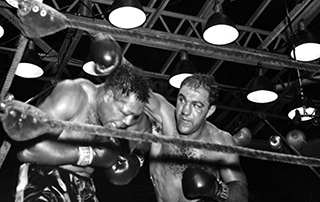
Photo: THE RING
Both men’s pace picked up considerably at the start of round four, which saw Marciano bull Moore to the ropes and land the harder punches at ring center. A powerful right to the forehead stunned Moore, prompting Marciano to unleash an extended torrent of power shots. Moore managed to roll away from most of the incoming and, from time to time, he uncorked sneaky rights that barely missed the target. A hard hook nailed Marciano near the end of the round but the determined champion continued to swing, swing and swing some more. Moore’s adroit upper body movement caused most of the blows to miss but the fear of missing had never stopped Marciano from throwing punches before and it certainly didn’t stop him now. Moore landed yet another short-range right just before the bell but, this time, Marciano took it unflinchingly, then continued to fire away until the bell. Moore landed a right to the Adam’s Apple a split-second after the bell, which only drew a wry smile from the champion.
Moore began the fifth at long range but his jabs and counters mostly deflected off Marciano’s gloves or missed completely. But by the one-minute mark Marciano, had cut the distance between them, which allowed him to resume the grinding-down process, albeit ineffectively at this juncture. Moore landed a couple of piercing counter rights as Marciano came in, which enabled him to narrowly take the round.
Moore’s nifty boxing continued in the first minute of the sixth but all that changed shortly before the midway point when a clanging right to the ear drove Moore to the canvas for the first time in the bout. Moore looked shaky as he arose at three and Marciano, sensing victory was at hand, swarmed all over the challenger with a fusillade of heavy swings, some of which missed but some of which landed with jolting force. Moore connected with a clean right-left-right but the blows only ignited an even more robust reply from Marciano, who uncorked a breathtaking series of hooks and overhand rights. Moore finally fell to a knee from a corkscrew right that struck the challenger’s temple as he was weaving away. Moore groggily arose at nine and somehow escaped each and every one of the eight blows Marciano threw in the final 10 seconds.
Moore, his eyes glassy and his mouth agape, looked all but finished as he trudged to his corner. Ringside physician Dr. Vincent Nardiello paid a visit to Moore’s corner between rounds, further indicating that the end was near. But, as the bell sounded for round seven, Moore, his mussed hair now combed and his eyes improbably brightened, moved energetically out of the corner and fought better than he had since round two. Marciano, no doubt arm-weary, nevertheless continued to pursue Moore but, now, he tasted a pair of snappy left-rights to the face that brought a roar from the Yankee Stadium crowd. Just as Marciano had rebounded from his knockdown, Moore was responding to his own tumble so positively that the Associated Press wrote that the 38-year-old had “dipped into his fountain of youth.”
The rally, however, was short-lived. As the round swung into its final minute, Marciano’s right to the back of the ear appeared to score a knockdown but Kessler ruled it a slip. Then Marciano cracked a rifle-shot right that swiveled Moore’s head, after which he maneuvered the challenger to the ropes and worked him over with his trademark swings for the remainder of the session. The assault swelled Moore’s right eye nearly shut and though he had to walk only a couple of steps toward his stool, even that morsel of effort strained him.
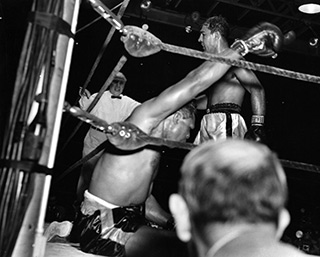
Photo: THE RING
The bone-weary Moore tried his best to keep Marciano at bay in the eighth and, for a while, he succeeded, thanks to a busy jab and occasional counter rights. Once Marciano cranked up the pressure, however, the futility of Moore’s quest became obvious. Though Marciano’s punches looked ponderous and slow, those that landed did so with telling force. With less than 10 seconds remaining, a right to the ear caused Moore to collapse in sections along the ropes. The bell sounded just as Kessler tolled six, saving Moore from a potential KO loss then and there.
Once again, Dr. Nardiello stopped by Moore’s corner, asking the challenger if he wanted the fight to be stopped.
“No,” Moore reportedly said. “It’s a championship. I want to be counted out in the ring.”
Marciano jumped on Moore like a ravenous piranha and chewed him up with his trademark blockbusters. Moments after taking Moore’s last gasp, a corking right uppercut to the jaw that Marciano took with aplomb, the champion landed a pair of clean concussive hooks that sat Moore down in his corner, his right arm draped over the bottom rope and his left glove grabbing the second strand. Moore, down for the fourth time, tried to haul himself up but his cornerman climbed onto the ring apron and pushed down on his charge’s left shoulder. Lacking the strength to resist, Moore fell to the floor and took the remainder of Kessler’s count.
The official time of the stoppage was 1:19 of the ninth round. After eight rounds, Marciano led 5-2-1, 5-3 and 7-1 on the rounds system and sweeping the sixth and eighth rounds. Even before his seconds could lift Moore onto the stool, Marciano walked over to congratulate his worthy opponent.
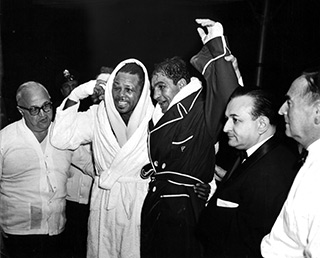
Photo: THE RING
Despite the beating he absorbed, Moore insisted he “enjoyed” the fight and noted that Marciano’s consistency was the determining factor. Though he would blame Kessler for his failure to capitalize on the second round knockdown, he didn’t do so during the immediate aftermath.
“I wasn’t warmed up yet,” he told the Associated Press.
He said he was willing to meet Marciano in a rematch and that he’d continue to fight heavyweights from time to time but, as for now, “I’ve got to go fishing.”
A sidebar story by the AP headlined “Rocky Will Fight Again,” reported that Marciano himself said he would defend the title next June against one of four opponents – Bob Baker, Nino Valdes, Tommy “Hurricane” Jackson or Floyd Patterson – and that he had no immediate thought of retirement. Manager Weill strongly confirmed that sentiment when he stated, “[Marciano] said ‘No.’ That’s definite. He’s not retiring.” Weill also said he had a $500,000 offer to have Marciano meet European champion Franco Cavicchi in Italy and that the US State Department was interested in having Marciano make a goodwill visit to Italy.
“There is a lot of pressure from my family for me to retire,” Marciano said. “My mother wants me to quit. So does my dad and my wife. It has been a pretty bad ordeal for them. I don’t know what I should do. Personally, at this point, I don’t feel I should retire.”
Seven months later, Marciano told the world he had changed his mind. While some cite back problems and pressure from his family, Hall of Fame trainer and close friend Lou Duva believes his hatred of Weill, mostly fueled by his 50 percent share of Marciano’s purses, motivated Marciano to step away.
“I still think to this day that he quit because he didn’t want to do business with his manager, Al Weill, any longer,” Duva said in Dave Anderson’s book “In the Corner.” “Al Weill was a lousy human being. He really used to rough up Rocky. He wouldn’t do nothing for Rocky and when Rocky found Weill was robbing him, that turned Rocky off.”
As it is with most great champions, rumors of a ring return circulated. According to Duva, it came very close to happening.
“Right after Ingemar Johansson knocked out Floyd Patterson to win the heavyweight title in 1959, Rocky had a deal where he was going to fight the Swede for a million-and-a-quarter. Tax free.” Duva told Anderson. “I know. I was going to train him. That’s when Cus D’Amato came up with Patterson’s hidden contract for the return bout [with Johansson]. That ended Rocky’s comeback before it even started. He was only 36. He was all set to do it.”
It’s just as well that Marciano-Johansson never happened. Although Marciano’s post-boxing life only lasted a little more than 13 years, his 49-0 record has propelled his legacy to stratospheric heights that he’ll never lose, even if Mayweather comes out of retirement, breaks the mark and retires for good.
Several legendary champions were able to exit the ring a winner and a few of them, most notably Ernesto Marcel when he thrashed future three-division champion Alexis Arguello, retired after beating a high-quality foe. But Marciano occupies a league all his own when it comes to final acts, for while he was less than graceful inside the ring, his departure was exceedingly so.
*
Lee Groves is a boxing writer and historian based in Friendly, W.Va. He is a full member of the BWAA, from which he has won 13 writing awards, including 10 in the last five years and two first-place awards since 2011. He has been an elector for the International Boxing Hall of Fame since 2001 and is also a writer, researcher and punch-counter for CompuBox, Inc. He is the author of “Tales from the Vault: A Celebration of 100 Boxing Closet Classics.” To order, please visit Amazon.com or email the author at [email protected] to arrange for autographed copies.















